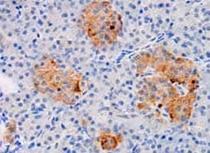Human/Mouse/Rat Gelsolin/GSN Antibody Summary
Met1-Ala782
Accession # P06396
*Small pack size (-SP) is supplied either lyophilized or as a 0.2 µm filtered solution in PBS.
Applications
Please Note: Optimal dilutions should be determined by each laboratory for each application. General Protocols are available in the Technical Information section on our website.
Scientific Data
 View Larger
View Larger
Detection of Gelsolin/GSN in Human Renal Cell Carcinoma via seqIF™ staining on COMET™ Gelsolin/GSN was detected in immersion fixed paraffin-embedded sections of human Renal Cell Carcinoma using Mouse Anti-Human Gelsolin/GSN, pan Monoclonal Antibody (Catalog # MAB8170) at 20ug/mL at 37 ° Celsius for 4 minutes. Before incubation with the primary antibody, tissue underwent an all-in-one dewaxing and antigen retrieval preprocessing using PreTreatment Module (PT Module) and Dewax and HIER Buffer H (pH 9; Epredia Catalog # TA-999-DHBH).Tissue was stained using the Alexa Fluor™ 647 Goat anti-Mouse IgG Secondary Antibody at 1:200 at 37 ° Celsius for 2 minutes. (Yellow; Lunaphore Catalog # DR647MS) and counterstained with DAPI (blue; Lunaphore Catalog # DR100). Specific staining was localized to the cytoplasm. Protocol available in COMET™ Panel Builder.
 View Larger
View Larger
Detection of Human, Mouse, and Rat Gelsolin/GSN by Western Blot. Western blot shows lysates of SK-Mel-28 human malignant melanoma cell line, MEF mouse embryonic feeder cells, and NR8383 rat alveolar macrophage cell line. PVDF membrane was probed with 0.5 µg/mL of Mouse Anti-Human/Mouse/Rat Gelsolin/GSN Monoclonal Antibody (Catalog # MAB8170) followed by HRP-conjugated Anti-Mouse IgG Secondary Antibody (Catalog # HAF018). A specific band was detected for Gelsolin/GSN at approximately 95 kDa (as indicated). This experiment was conducted under reducing conditions and using Immunoblot Buffer Group 1.
 View Larger
View Larger
Detection of Human Gelsolin/GSN by Simple WesternTM. Simple Western shows lysates of Exosome Standards (HT‑29) (NBP3-11685), Exosome Standards (U‑87 MG) (NBP2-49844) and SK‑Mel‑28 human malignant melanoma cell line, loaded at 0.5 mg/ml. A specific band was detected for Gelsolin/GSN at approximately 90 kDa (as indicated) using 20 µg/mL of Mouse Anti-Human/Mouse/Rat Gelsolin/GSN Monoclonal Antibody (Catalog # MAB8170). This experiment was conducted under reducing conditions and using the 12-230kDa separation system.
 View Larger
View Larger
Gelsolin/GSN in Human Kidney. Gelsolin/GSN was detected in formalin fixed paraffin-embedded sections of human kidney using Mouse Anti-Human/Mouse/Rat Gelsolin/GSN Monoclonal Antibody (Catalog # MAB8170) at 15 µg/mL overnight at 4 °C. Tissue was stained using the Anti-Mouse HRP-DAB Cell & Tissue Staining Kit (brown; Catalog # CTS002) and counterstained with hematoxylin (blue). Specific staining was localized to glomeruli and distal convoluted tubules. View our protocol for Chromogenic IHC Staining of Paraffin-embedded Tissue Sections.
 View Larger
View Larger
Western Blot Shows Human Gelsolin/GSN Specificity Using Knockout Cell Line. Western blot shows lysates of U2OS human osteosarcoma cell line and Gelsolin/GSN knockout U2OS cell line (KO). Nitrocellulose membrane was probed with 0.1 µg/mL of Mouse Anti-Human/Mouse/Rat Gelsolin/GSN Monoclonal Antibody (Catalog # MAB8170) followed by HRP-conjugated Anti-Mouse IgG Secondary Antibody. A specific band was detected for Gelsolin/GSN at approximately 80 kDa (as indicated) in the parental U2OS cell line, but is not detectable in knockout U2OS cell line. The Ponceau stained transfer of the blot is shown. This experiment was conducted under reducing conditions. Image, protocol, and testing courtesy of YCharOS Inc. See ycharos.com for additional details.
Reconstitution Calculator
Preparation and Storage
- 12 months from date of receipt, -20 to -70 °C as supplied.
- 1 month, 2 to 8 °C under sterile conditions after reconstitution.
- 6 months, -20 to -70 °C under sterile conditions after reconstitution.
Background: Gelsolin/GSN
Gelsolin, also known as GSN, actin-depolymerizing factor/ADF, AGEL and Brevin, is a 90-95 kDa member of the villin/gelsolin family. Widely expressed, Gelsolin binds to actin and fibronectin, and is found both secreted in plasma and in cytoplasm. Cytoplasmic Gelsolin lacks 51 N-terminal amino acids (aa) present in the secreted protein. Gelsolin was identified by its ability to sever actin filaments in the presence of submicromolar calcium, and plays a role in ciliogenesis. Defects in Gelsolin cause amyloidosis type 5, a hereditary disease characterized by gelsolin amyloid deposition. Full-length human Gelsolin is 782 aa and shares 93% aa identity with mouse and rat Gelsolin.
Product Datasheets
Citation for Human/Mouse/Rat Gelsolin/GSN Antibody
R&D Systems personnel manually curate a database that contains references using R&D Systems products. The data collected includes not only links to publications in PubMed, but also provides information about sample types, species, and experimental conditions.
1 Citation: Showing 1 - 1
-
Lower Expression of Gelsolin in Colon Cancer and Its Diagnostic Value in Colon Cancer Patients
Authors: Z Chen, K Li, X Yin, H Li, Y Li, Q Zhang, H Wang, Y Qiu
J Cancer, 2019-01-30;10(5):1288-1296.
Species: Human
Sample Types: Whole Cells
Applications: Neutralization
FAQs
No product specific FAQs exist for this product, however you may
View all Antibody FAQsReviews for Human/Mouse/Rat Gelsolin/GSN Antibody
Average Rating: 5 (Based on 1 Review)
Have you used Human/Mouse/Rat Gelsolin/GSN Antibody?
Submit a review and receive an Amazon gift card.
$25/€18/£15/$25CAN/¥75 Yuan/¥2500 Yen for a review with an image
$10/€7/£6/$10 CAD/¥70 Yuan/¥1110 Yen for a review without an image
Filter by:

